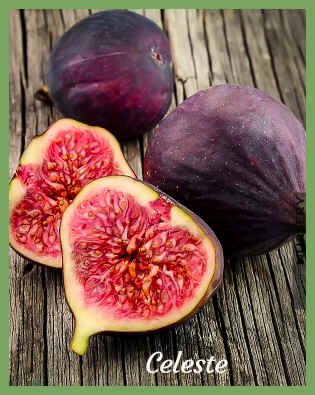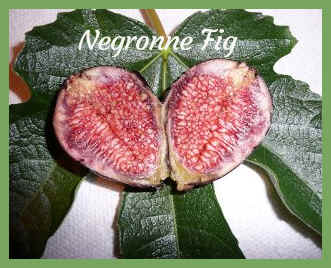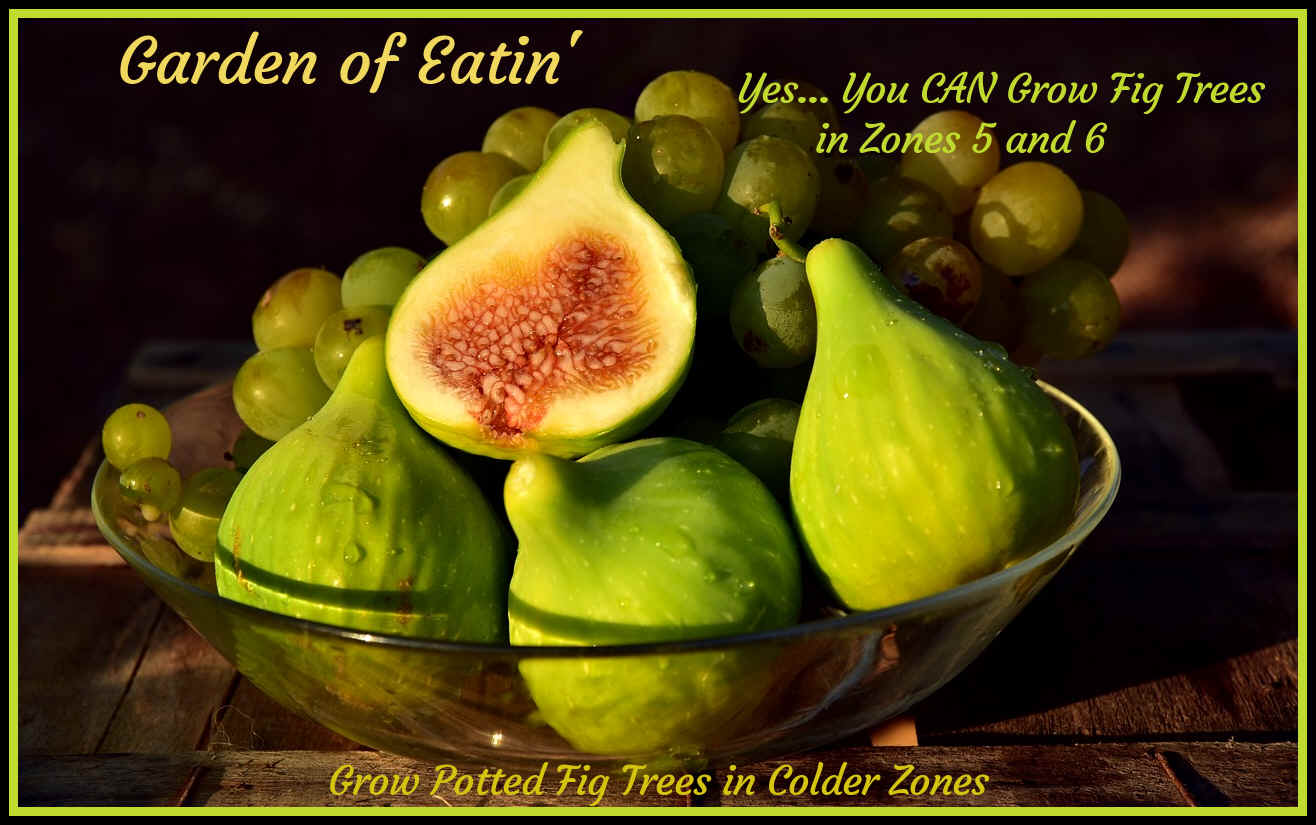 |
My foray into the world of growing cold hardy fig trees in a northern climate...... will be growing the trees in big pots. I've started a small backyard fruit orchard, and my favorite fruit to experiment with next is the fig. In pots. The fig has great historical significance, but i'm just interested in the fruit. And lots of it. Fig trees, when compared to other fruit trees, have one of the shortest wait times before you should expect to bite into that fruit: usually only 1-2 years after planting. Less, for dwarf tree varieties. Some varieties produce figs twice a year, sometimes on bare stems. Check out this page for the inspiring story of Italian immigrants and their beloved fig trees, the symbolism, and the customs that surround it's care. I've put together this page of information on growing the fig trees, dwarf or dwarfed by me, that i will be following myself.... this is my first experience with attempting to grow and eat my own figs. All will be grown in pots. I will be learning, too, and practicing what i type. I'm sure my mistakes will be valuable to you in your fig growing endeavors. I'll begin by saying that i live in
the northern U.S., and will therefore be growing cold hardy types for
Zone 6. Mostly. My reasons for pots are that i garden so intensely, that i'm running out of horizontal space to plant something that will need root space to grow unhindered. And I am a compulsive re-decorator of my theme gardens. I appreciate the portability that encourages my fickle decisions about where to grow a plant. I also like the idea of being able to grow and care for non-hardy varieties by just lugging, (or wheeling) the potted plants into my house to sleep for the winter. During my self-imposed distancing during Covid-19, i have learned not to care or keep secret that my dining room looks like an indoor plant nursery, with 20+ grow lights of all types - clip on, hanging, and telescoping floor-standing lights with arms like an octopus - placed over that many plants, and a nice window to supplement that. I'm learning a trick or two about timing, pruning, dormancy and such. And i don't have to shove things out of the way when I have guests, because there usually aren't any. I begin to question whether i prefer humans or plants in my dining room. All varieties of baby perennials, non-hardy succulents and trees I over-wintered performed very well with that setup. Sleeping trees do not need light or much water until breaking dormancy. Trees budding out or with leaves left on, do. Severe pruning is best done in winter when the plant is dormant. I am concentrating on dwarf or semi-dwarf trees that I can keep at a particular height, so that i can prune and pick without standing on a scary ladder. That would be any ladder with more than 2 steps. I choose self-pollinating varieties that don't need a partner to grow fruit. They will be placed near my pollinator-attracting plants, so they will have an even bigger and better crop. Self-pollinating trees, to me, sounds like I can have twice as many varieties. I limit myself to growing in planters no bigger than 5 gallons - to keep them small and light enough to carry the winter-shy varieties indoors. I road-tested the future chore of moving trees and soil and pot, and i determined that 5 gallon pots are the most I can handle by myself, including the climbing of steps. You can find your maximum weight requirements, so you might be able to use a 7 gallon pot. Figs really don't have a preference. They grow into their pot sizes, and then you can repot and upsize, or trim the roots and repot into the same size container. The only thing they do not go for is soil that is not well-draining. Sitting water is deadly for a fig tree. It's easy to prune and care for dwarf variety trees, but you can dwarf the size of any fig tree with proper pruning to keep it dainty and at the height you want it to be. You can even let the fig tree be a bush in a pot. Espalier fruit tree gardening is fun to try. You can prune and grow several trees in a sheltered location this way. 2021 Update - My very
first Brown Turkey Fig grown from a rooted tree cutting, and planted in a
big pot this spring, was quite deelish.
To begin, here are the suggested varieties of fig tree to grow in my area (Zone 6b), that are described as cold hardy, or at least borderline, according to my research. Many varieties of fig are hardy to Zone 7, are described as also being prolific in Zones 5 and 6 if grown in a sheltered area, or steps are taken to insulate the tree. Remembering that potted trees freeze faster than trees planted in the ground, is a good idea. You can look up fig trees that are hardy to your area in nursery listings for the tree, but I would double-check with fig tree collectors, growers and nurseries to be sure. They specialize, so I trust that more. If you're growing in pots and have a cold basement, garage or shed, you can bring the pots inside to sleep through the winter after the leaves drop, so cold hardiness won't matter, you don't have to wrap the trees like mummies, and you can choose almost any fig tree. Do yourself a big favor, and purchase your trees from reputable plant nurseries and fig breeders. I don't trust anything from big box stores, home centrs and flea markets to be grown pesticide and GMO-free, or be true to the species named on the tag. Container PlantingGet a nice, big, pot - make it plastic unless you don't plan on ever moving it around in your garden. I love the terra cotta and stone pots, but i ain't moving those - I suggest 5-7 gallon pots. Figs don't need all that much room in a pot. Plant in well-draining soil and skip the fertilizer at planting time. After planting your fig tree in its container, water it well, then add a layer of mulch. The mulch will keep the soil from drying out too quickly, and you can laugh at weeds. Put the fig tree in a sunny spot in your yard, and keep well-watered. During hot summer weather, your fig tree may need more frequent watering, possibly even daily. Observe and respond accordingly to your tree's environment. If your tree's leaves begin to yellow, chances are it is being over-watered. Pruning your fig tree. Unlike most other fruit trees, fig trees typically don't require routine pruning, but you can prune them to a size that works for your space. Depending on the variety, average fig trees naturally mature around 10- to 15-feet tall or larger. Many fig-tree growers find that keeping them between 6-8 feet tall is most manageable, especially in a container. Some fig trees have a natural bush-like appearance if allowed to grow naturally. If your fig tree has more of a "bushy" shape and you'd prefer one main trunk, you can prune the additional low growth out until you are left with one main trunk. I do this regularly with all of my potted trees and shrubs. In the fall, when the leaves start
to turn and fall before the first killing frost, it is time to move
the not-so-hardy fig trees you've planted into an unheated basement,
garage, or shed where the fig tree will go dormant. Check occasionally
during the dormant period for soil moisture. As warmer weather arrives, move the fig tree (this should be easy because you made sure you planted it in a pot you can lift, right?) out to the yard for just a few hours every day. This will help acclimate it back to its favored warm weather. Take it back indoors in the evenings. When the last frost date has passed for your area, move the fig tree back to a sunny spot outdoors. There is some info online about planting bare root, dormant trees as soon as the soil can be worked, and before the last frost date - that's for those of us who purchase bare root plants and need to pot them or plant them when they arrive. In summer, water weekly or more often, in heat/dry spells. Of course, the best place to plant fig trees in the ground, is close to a south-facing wall or structure. It's warmer and sheltered there in winter. Potted fig trees can do well there, too, if given a lot of mulch, moved close together, or their pots are insulated. I've heard tales of zone 6b gardeners growing all types of cold hardy fig trees, and they never mulched. I'm not feeling that lucky. Especially with young, finicky and fairly expensive trees. The listing below are my beginning
choices, based on research on figs that are cold-hardiest. Most growers
agree that you can grow figs in-ground in zone 6b with minimal
protection. The descriptions were provided by nurseries and
growers. |
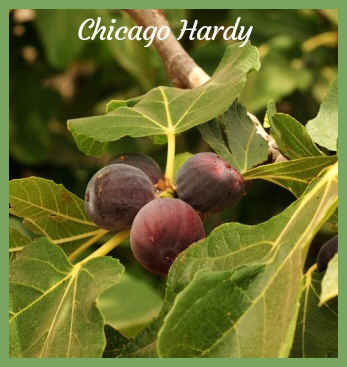
|
Full sun, hardy in Zones
6-10
One of the hardiest of its kind, Chicago Hardy endures colder zone 6 winters. Also known as Bensonhurst Purple, originating in Sicily. Self-pollinating. Will often tolerate zone 5 temperatures if given a sheltered location and root protection. This tree produces sweet, light purplish-brown figs with pink flesh that ripen in late summer. Not a dwarf, but can be kept small when pruned and container-grown. Mine will be kept pruned at 6-8 ft.
|
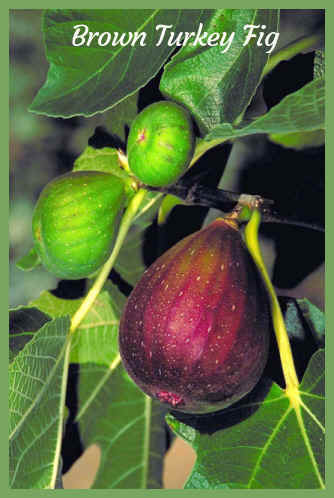 |
I named one
"Tom."
Produces very tasty, brownish purple fruit in late spring and again in late summer.
Full sun, USDA Zones 7-9
Two yearly crops of fruit. Water regularly - weekly, or more often in extreme heat or containers. Highly adaptable, and often root hardy and prolific in zones 5 and 6 if planted in a sheltered location and given winter protection. A beautiful specimen for garden or landscape, requiring only a light annual pruning. Moderate growing; reaches 15 to 25 ft. tall and wide at maturity. Medium size makes it good for screening or as background. For a specimen plant, prune carefully to reveal it's structure.
|
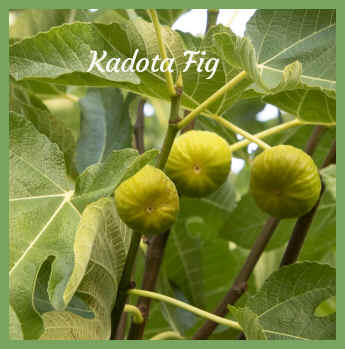
|
Full Sun, Zones 7-9 Moderate growing; reaches 15 to 25 ft. tall and wide. Keep small by pruning. Hardy to zone 5 with protection. Intriguing branching spread that provides excellent winter character. A reliable fall harvest of especially sweet, greenish yellow fruit. Highly decorative and adaptable. |

|
Zones 7-9
Grows to 15 ft. tall and wide; easily kept to 6 ft. with annual pruning. This semi-dwarf Fig is well-suited for small urban gardens where space is limited. |
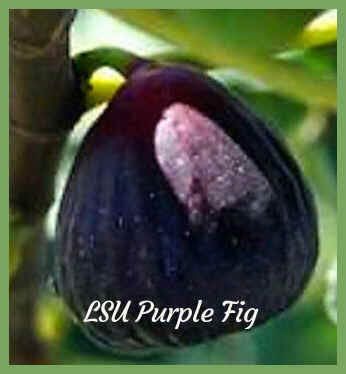 |
Zones 7-10
Often root hardy and prolific in zones 5 and 6 if planted in a sheltered location, with winter protection. The LSU Purple fig has a closed eye fruit (yay, no wasps!) that is medium in size and this tree is self-pollinating. It is a very reliable and prolific producer of early to late figs. It also is excellent for containers.This fig tree has an upright growth pattern and is very vigorous. The color is glossy dark purple with a reddish tint. |
|
|
‘Celeste’ is cold-resistant to 0°F – like what you will find in Zones 5 and 6 – and does especially well in Zones 7-9. Full Sun. You will have to offer the tree protection in the colder zones of 5 and 6. In colder zones, grow your tree in a pot, and bring it into a cool, frost-free area for winter. Keep it dry in the pot. Sunlight is not necessary in winter dormancy. This low-maintenance tree is self-fertile. It’s not picky about soil, as long as it is well-draining. Great choice for small yards. It grows in a multi-trunk or bushy manner. It grows easily, even in poor, dry soil. |
|
|
Dwarf
Negronne
Fig -"Violette de Bourdeaux"
|
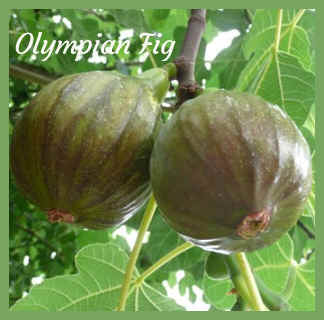 |
The Olympian Fig is an heirloom tree that produces big fruit, as large as a tangerine.Zones 6-9 Hardy in temperatures into the teens. The plant itself is hardy down to zero degrees once well established, even though it will freeze to the ground. It will return in the spring and bear a crop of fruit the following summer. It would do well at below zero temperatures, and perhaps will not die to the ground with winter protection. 10ft x 10ft at maturity, if not pruned to be shorter. |
| Sources:
Stark Bros. Nursery |
Quick Links For Garden Design
Content, graphics and design ©2021 marysbloomers.com
This
site uses Watermarkly Software



